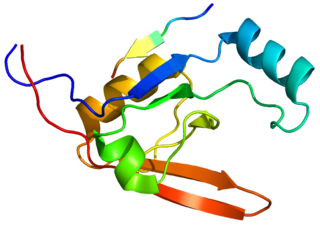
A single-nucleotide polymorphism, often abbreviated to SNP, is a variation in a single nucleotide that occurs at a specific position in the genome, where each variation is present to some appreciable degree within a population.

Sodium/Calcium(Potassium-dependent) exchanger 5 (NCKX5), also known as solute carrier family 24 member 5 (SLC24A5), is a protein that in humans is encoded by the SLC24A5 gene that has a major influence on natural skin colour variation. The NCKX5 protein is a member of the potassium-dependent sodium/calcium exchanger family. Sequence variation in the SLC24A5 gene, particularly a non-synonymous SNP changing the amino acid at position 111 in NCKX5 from alanine to threonine, has been associated with differences in skin pigmentation.

The mammalian 5-HT2A receptor is a subtype of the 5-HT2 receptor that belongs to the serotonin receptor family and is a G protein-coupled receptor (GPCR). 5-HT is short for 5-hydroxy-tryptamine, which is serotonin. This is the main excitatory receptor subtype among the GPCRs for serotonin, although 5-HT2A may also have an inhibitory effect on certain areas such as the visual cortex and the orbitofrontal cortex. This receptor was first noted for its importance as a target of serotonergic psychedelic drugs such as LSD. Later it came back to prominence because it was also found to be mediating, at least partly, the action of many antipsychotic drugs, especially the atypical ones.
The 5-HT3 receptor belongs to the Cys-loop superfamily of ligand-gated ion channels (LGICs) and therefore differs structurally and functionally from all other 5-HT receptors (5-hydroxytryptamine, or serotonin) receptors which are G protein-coupled receptors. This ion channel is cation-selective and mediates neuronal depolarization and excitation within the central and peripheral nervous systems.

Prostaglandin E2 receptor 4 (EP4) is a prostaglandin receptor for prostaglandin E2 (PGE2) encoded by the PTGER4 gene in humans; it is one of four identified EP receptors, the others being EP1, EP2, and EP3, all of which bind with and mediate cellular responses to PGE2 and also, but generally with lesser affinity and responsiveness, certain other prostanoids (see Prostaglandin receptors). EP4 has been implicated in various physiological and pathological responses in animal models and humans.

5-Hydroxytryptamine receptor 4 is a protein that in humans is encoded by the HTR4 gene.

The serotonin 1A receptor is a subtype of serotonin receptor that binds the neurotransmitter serotonin. It is a G protein-coupled receptor (GPCR), coupled to the Gi protein, that mediates inhibitory neurotransmission. The serotonin 1A receptor is encoded by the HTR1A gene.

5-hydroxytryptamine receptor 1B also known as the 5-HT1B receptor is a protein that in humans is encoded by the HTR1B gene. The 5-HT1B receptor is a 5-HT receptor subtype.

Serine protease HTRA2, mitochondrial is an enzyme that in humans is encoded by the HTRA2 gene. This protein is involved in caspase-dependent apoptosis and in Parkinson's disease.

RAD52 homolog , also known as RAD52, is a protein which in humans is encoded by the RAD52 gene.

Serine protease HTRA1 is an enzyme that in humans is encoded by the HTRA1 gene. The HTRA1 protein is composed of four distinct protein domains. They are from amino-terminus to carboxyl-terminus an Insulin-like growth factor binding domain, a kazal domain, a trypsin-like peptidase domain and a PDZ domain.

ATP-binding cassette transporter sub-family C member 11 is a protein that in humans is encoded by the ABCC11 gene.

Chloride channel protein ClC-Ka is a protein that in humans is encoded by the CLCNKA gene. Multiple transcript variants encoding different isoforms have been found for this gene.
In genetics, rs6313 also called T102C or C102T is a gene variation—a single nucleotide polymorphism (SNP)—in the human HTR2A gene that codes for the 5-HT2A receptor. The SNP is a synonymous substitution located in exon 1 of the gene where it is involved in coding the 34th amino acid as serine.
In genetics, rs6311 is a gene variation—a single nucleotide polymorphism (SNP)—in the human HTR2A gene that codes for the 5-HT2A receptor. 5-HT2A is a neuroreceptor, and several scientific studies have investigated the effect of the genetic variation on personality, e.g., personality traits measured with the Temperament and Character Inventory or with a psychological task measuring impulsive behavior. The SNP has also been investigated in rheumatology studies.
In genetics, rs7997012 is a gene variation—a single nucleotide polymorphism (SNP)—in intron 2 of the human HTR2A gene that codes for the 5-HT2A receptor. The SNP varies between adenine (A) and guanine (G) DNA bases with the G-allele being most frequent. A research study found it to be related to antidepressant treatment. The research group reported that a polymorphism (rs1954787) on another gene, the GRIK4, has also shown a treatment-response-association in this kind of treatment. In a Japanese study rs7997012 was not associated with neither major depressive disorder nor bipolar disorder.
In genetics, rs6314, also called His452Tyr or H452Y, is a gene variation, a single nucleotide polymorphism (SNP), in the HTR2A gene that codes for the 5-HT2A receptor. The SNP is located in exon 3 of the gene and the change between C and T results in a change between histidine (His) and tyrosine (Tyr) at the 452nd amino acid, i.e., it is a missense substitution.
In genetics, Rs1805054, also called C267T, is a name used for a specific genetic variation, a single nucleotide polymorphism (SNP), in the HTR6 gene. It is one of the few investigated polymorphisms of its gene. C267T is a synonymous polymorphism.

5-hydroxytryptamine (serotonin) receptor 3B, also known as HTR3B, is a human gene. The protein encoded by this gene is a subunit of the 5-HT3 receptor.












